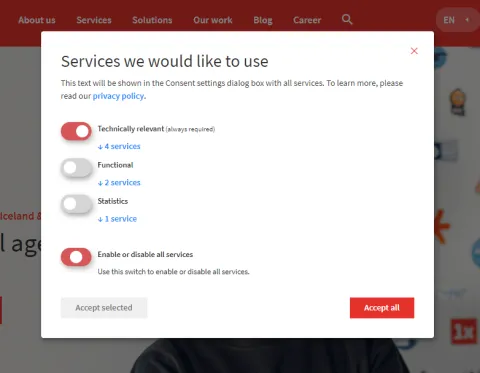GDPR Cookie Consent Banner
According to the judgment of the Federal Court of Justice (BGH) on May 28, 2020, active consent from website visitors is required before data can be sent to a third party.
But what does this mean and what changes must be made on websites? In this blog post, we will explain what has changed.
Until these changes were introduced, so-called cookie notification banners have mostly been used on websites. These notifications indicated that cookies are used and referred to the website privacy policy, in which all cookies are listed.
With the ruling of the BGH, this is no longer sufficient. Data may now only be sent to a third party with active consent.
This means that no data may be sent until the website visitor actively consents. If the website visitor has not actively consented, then the data must not be sent.
An example for third party:
- Google Analytics / Google Tag Manager
- YouTube
- Google Maps / reCAPTCHA
- etc.

Cookie Consent Banner
The Consent banner gives the website visitors the opportunity to opt in, or in other words, give their self-determined and active consent. The Consent banner lists all third parties that can be actively accepted or rejected by the user.
From the technical side, all data may be sent to the corresponding third party only with the active consent of the Consent Banner.
For example: Google Analytics tracks the user from the moment they enter the website, but this data may only be set and tracked using Google Analytics after the user has given their consent.
What are the types of Consent Banner?
Currently there are two types of Consent Banner:
Service companies such as:
- Cookiebot
- CookieHub
- Usercentrics
- etc.
- Open source tools like Klaro, which can be installed on your own server without monthly fees.

What is the difference?
Service provider
Service providers advertise with automatic scans and a user-friendly interface.
In the tools, it is usually possible to change basic settings such as colour, position and layout of the banner independently. Texts and translations can also be maintained independently.
The website is scanned at regular intervals and third party services are indicated on the website.
This service is subject to a fee.
Klaro Open Source Tool
Open source tools like Klaro are integrated directly on the website, individually styled and hosted.
The settings and stylings have to be done by the developers.
Apart from the set-up fees, there are no additional monthly hosting fees.
Technical modifications
In addition to integrating and configuring the Consent Banner, each script of a third party must be adapted so that they are only executed with consent in the Consent Banner.
For example: that data is only sent to Google Analytics when consent has been given via the Consent Manager.
Services such as Youtube also need a display if the consent was not given.
This is best done with a direct option to give consent and then display the video to the user.
Conclusion
Regardless of which Cookie Consent Banner (service provider or an open source tool) is chosen, the scripts on the website must be individually adapted so that they can be controlled via the Consent Banner.
It is not sufficient to only integrate the Consent Banner.
Each individual script (e.g. Google Analytics, YouTube, etc.) must be individually customized and may only be activated with the consent of the user.
Related blogposts
How-to: Obtain User Consent Prior to Loading Videos (2-click video solution)

Displaying videos from YouTube or Vimeo on websites is a common practice used to create more...
Web Accessibility and synergies to SEO

The purpose of web accessibility and web design is to ensure that certain groups of people, for...